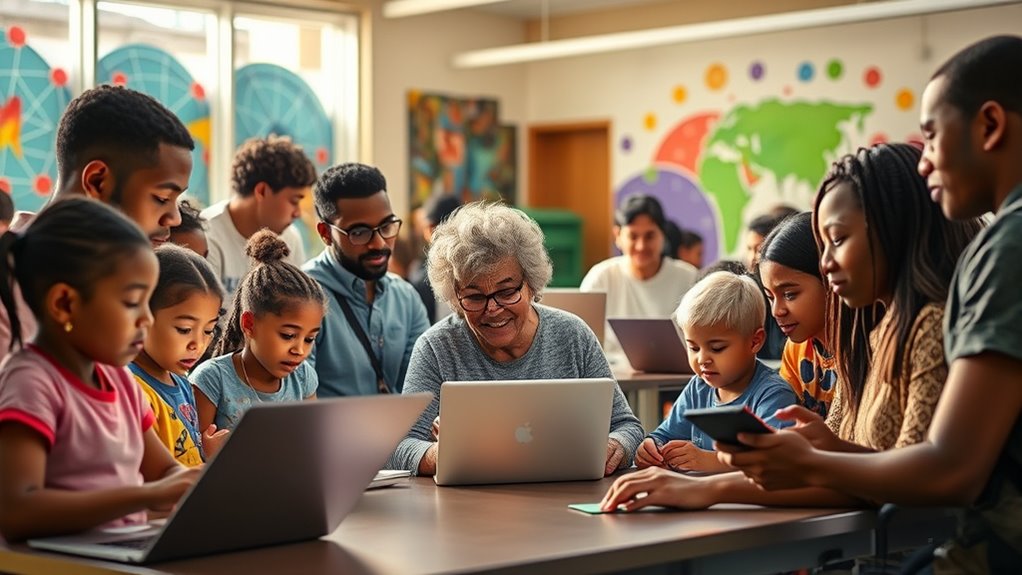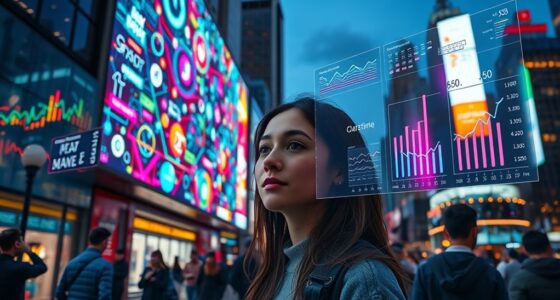Bridging the digital divide in 2025 means expanding access to reliable internet, affordable devices, and tailored digital literacy programs. You’ll find efforts from governments, companies, and nonprofits working together to make digital tools accessible for all, including marginalized communities. Inclusive design guarantees everyone can participate fully online. If you keep exploring, you’ll discover how these innovations and collaborations are shaping a more equitable digital future for everyone.
Key Takeaways
- Enhanced digital literacy programs and tailored education initiatives are expanding digital skills for underserved populations.
- Investments in affordable internet infrastructure and devices are increasing connectivity in rural and low-income areas.
- Inclusive design and accessibility features in digital tools ensure equitable access for people with disabilities and limited skills.
- Cross-sector collaboration among governments, private companies, and nonprofits accelerates digital inclusion efforts.
- Technological and policy advancements by 2025 aim to significantly reduce the digital divide, fostering a more equitable society.

Will technology truly become more inclusive by 2025? It’s a question that’s on many minds as efforts to bridge the digital divide accelerate worldwide. You recognize that digital literacy plays a pivotal role in this movement. When people understand how to navigate digital tools, they can access opportunities that were previously out of reach. Improving digital literacy isn’t just about teaching basic skills; it’s about empowering individuals to participate fully in a digital society. Many organizations are working to provide training programs, online courses, and community workshops tailored to diverse needs, ensuring that everyone, regardless of background, can develop the skills necessary to thrive online.
Digital literacy empowers individuals to access new opportunities and participate fully in a connected society.
However, technology’s promise to be truly inclusive hinges on affordable access. Without reliable, inexpensive internet and devices, even the most digitally literate individuals face barriers. You see governments, private companies, and nonprofits investing in infrastructure projects to expand broadband coverage in underserved areas. These efforts aim to bring affordable access to rural communities, low-income neighborhoods, and marginalized groups that have historically been left behind. When access becomes more affordable, people are more likely to use digital services for education, healthcare, employment, and civic engagement, creating a more equitable landscape. Additionally, advancements in projector technology demonstrate how innovative tools can enhance digital inclusion by providing accessible and versatile options for diverse environments.
As these initiatives grow, you notice a shift in how digital tools are designed and delivered. Developers are increasingly prioritizing accessibility features, ensuring that websites and apps work for people with disabilities or limited technical skills. This inclusive approach makes digital environments friendlier for all users, not just the tech-savvy. The integration of user-friendly interfaces, multilingual options, and assistive technologies helps break down barriers that once hindered participation. This development is essential because inclusion isn’t just about giving access; it’s about making sure everyone can effectively use digital resources to improve their lives.
By 2025, you can expect a significant increase in collaborative efforts aimed at closing the digital gap. Governments are rolling out policies that promote digital literacy programs, subsidize internet costs, and support digital skill-building initiatives. Private sector companies are working to create affordable devices and develop innovative solutions tailored to underserved populations. Nonprofits are amplifying their outreach, helping communities understand and leverage digital tools. This collective push is indispensable because bridging the digital divide requires a multifaceted approach—combining education, infrastructure, and technology design.
In the end, whether technology becomes more inclusive by 2025 depends on the commitment from all sectors to prioritize digital literacy and affordable access. When these elements come together, you’ll see a future where digital opportunities aren’t limited by geography, income, or ability. Instead, they become accessible and empowering for everyone, helping to create a truly connected and equitable society.
Frequently Asked Questions
How Will AI Impact Digital Inclusion Efforts by 2025?
By 2025, AI will substantially enhance digital inclusion efforts. You’ll see improved AI accessibility, making technology usable for everyone, regardless of ability. Personalized learning powered by AI will help you access tailored educational resources, bridging gaps in knowledge. This guarantees marginalized communities gain better digital access, empowering you to participate fully in the digital world. AI’s role in fostering inclusivity will make technology more equitable and accessible for all.
What Role Do Private Companies Play in Bridging the Digital Divide?
You should know that private companies play a vital role in bridging the digital divide, with 63% of tech firms prioritizing digital inclusion initiatives. Their corporate responsibility drives investments in affordable internet and devices. Through innovation partnerships, they develop accessible technologies, expand infrastructure, and reach underserved communities. By actively engaging in these efforts, you help create equitable access, ensuring everyone can benefit from digital opportunities and close the gap in tech inclusion.
Are There Any International Initiatives Supporting Global Tech Access?
Yes, there are international initiatives supporting global tech access. You should know about global partnerships like the World Bank and ITU collaborating with governments to fund infrastructure investments in underserved regions. These efforts aim to expand internet connectivity, provide affordable devices, and train local communities. By participating in or supporting these initiatives, you can help bridge the digital divide and promote tech inclusion worldwide, ensuring more equitable access to digital resources.
How Will Emerging Technologies Like 5G Influence Digital Equity?
While 5G promises faster connectivity, it can also widen the digital gap if access remains uneven. You’ll see it shape Smart Cities, making services more efficient and accessible. However, without improving digital literacy, many will still be left behind. To truly promote digital equity, you need to guarantee emerging tech benefits everyone equally, bridging the divide rather than deepening it.
What Policies Are Most Effective in Promoting Tech Inclusion?
You should focus on policies that boost digital literacy and prioritize infrastructure investment. These are the most effective ways to promote tech inclusion because they guarantee everyone understands how to use technology and has reliable access. Supporting funding for community programs and expanding high-speed internet in underserved areas helps bridge gaps. By implementing these policies, you can create a more equitable digital landscape where everyone benefits from technological advancements.
Conclusion
By 2025, you’ll see the digital divide shrinking like a fading shadow, giving everyone a chance to step into the light of opportunity. Tech inclusion acts as a bridge, connecting communities and opening doors that once seemed closed. Together, you’ll be part of a movement where innovation becomes a universal language, transforming barriers into pathways. Embrace this future, where technology’s promise is a tapestry woven with threads of equality and hope, brightening the world for all.









